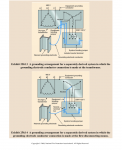Grouch1980
Senior Member
- Location
- New York, NY
Hi,
I put 'non' in caps since most of the previous posts i went through had to do with transformers feeding a building. In my case below, this is a transformer being fed BY a building...
In a particular project i am working on, we are designing for a new feeder to originate from an existing 480 volt switchboard inside a building. The feeder will exit the building, connect to a step-down delta-wye transformer for 120/208 volt secondary, and feed a 120/208 volt switchboard next to it. both the transformer and switchboard are outdoors. I am connecting the GEC from a ground rod to the neutral inside the transformer, and providing a system bonding jumper from the transformer neutral terminal to the grounding terminal at the main switch on the load side of the transformer.
My questions are: (simple questions, but can still get you in trouble)
1. is the 8 foot ground rod all I need as a grounding electrode system for this application?
2. How far away can the ground rod be from the transformer? can it be directly underneath, to the side, 50 feet away, or it doesn't matter?
Thanks!
I put 'non' in caps since most of the previous posts i went through had to do with transformers feeding a building. In my case below, this is a transformer being fed BY a building...
In a particular project i am working on, we are designing for a new feeder to originate from an existing 480 volt switchboard inside a building. The feeder will exit the building, connect to a step-down delta-wye transformer for 120/208 volt secondary, and feed a 120/208 volt switchboard next to it. both the transformer and switchboard are outdoors. I am connecting the GEC from a ground rod to the neutral inside the transformer, and providing a system bonding jumper from the transformer neutral terminal to the grounding terminal at the main switch on the load side of the transformer.
My questions are: (simple questions, but can still get you in trouble)
1. is the 8 foot ground rod all I need as a grounding electrode system for this application?
2. How far away can the ground rod be from the transformer? can it be directly underneath, to the side, 50 feet away, or it doesn't matter?
Thanks!

